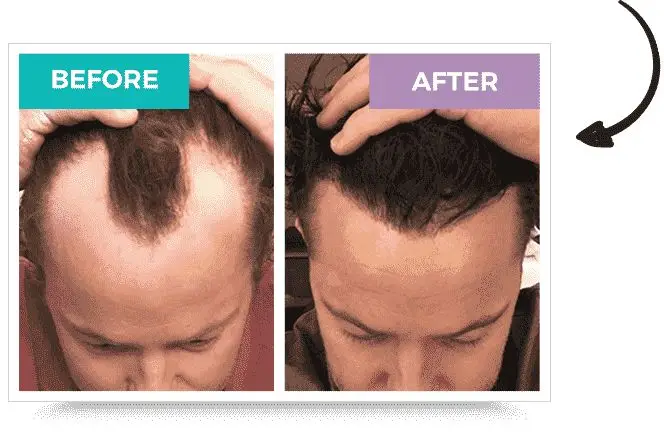A duo that is quite popular for hair loss is minoxidil and finasteride. Both these drugs are used in the treatment of many different types of hair loss. However, they work quite differently.
In fact, as far as minoxidil is concerned, its mechanism of action is still not well understood. But there are different theories which explain the ways in which it promotes hair growth (because it is an effective drug).
However, when considering using these drugs for their alopecia, many people are unsure about which one to use. Also, they don’t know if both can be used together to give an even bigger boost to their hair growth.
In this guide, you’ll learn more about the differences between minoxidil and finasteride and how you can use them.
What Are The Differences Between Minoxidil and Finasteride?
The main difference between minoxidil and finasteride is their mechanism of action. Finasteride is a drug that stops the conversion of testosterone into dihydrotestosterone.
Minoxidil, on the other hand, is believed to increase blood flow to the scalp by dilating blood vessels, lengthening the anagen phase of hair growth, or even that it has an anti-androgenic effect like finasteride.

Initially, both of these FDA-approved drugs weren’t developed for hair loss. Minoxidil (Rogaine) was developed as a treatment for high blood pressure, and finasteride for benign prostatic hyperplasia, a condition in which the prostate glands are enlarged.
Regardless, it was found that the drug finasteride (Propecia) acted as an inhibitor of the enzyme 5α-reductase, which is responsible for the conversion of the hormone testosterone into dihydrotestosterone (DHT).

DHT is the reason why men lose hair as a result of male pattern baldness. By binding to the hair follicles, it leads to their shrinkage and weakened state, eventually causing irreparable damage.
With the finasteride inhibiting the action of the enzyme, the DHT will not bind to the hair follicles. This is how finasteride works and stops hair loss. Many studies have shown promising results from the use of this drug.
But minoxidil can only promote the growth of hair by increasing the supply of nutrients and oxygen to the hair follicles on the scalp.
It is a vasodilator and is generally sprayed on the scalp. This causes the blood vessels to dilate and carry more, well, blood.
You can find a topical solution or foam of minoxidil, while finasteride is available as an oral pill (this is the FDA-approved form of it). Some companies also make combo minoxidil and finasteride topical solution.
Should You Take Finasteride and Minoxidil Together?
Minoxidil and finasteride can work alone. However, it is also safe to take them together.
But before you take finasteride and minoxidil together, you need to consult your doctor. It is extremely important. They can interact harmfully with some other drugs that you might be taking.

So, make sure to inform your doctor about all the drugs that you’re already taking, including vitamins.
Even before starting a new drug, you need to ask your doctor to ensure that it will not interact dangerously with these hair loss medications.
Together these two drugs are effective against hair loss. Considering the way these drugs work to promote hair growth, minoxidil and finasteride results can be quite good.
Their combination has been shown to improve hair loss. However, it is just as possible for these to not work at all, together or on their own.
How To Use Finasteride And Minoxidil?
For hair loss, usually, 1mg of finasteride is prescribed once a day. It’s available as an oral tablet.
But minoxidil is available as a topical solution. There are sprays, foams, and droppers that you can use. You might be advised to apply it twice a day.

According to the Mayo Clinic, adults only need to apply 1 millilitre of it every day. You can part your hair and then rub the solution in.
However, you need to avoid getting your hair wet or showering for at least 4 hours. But in any case, make sure to further consult your doctor about it.
As far as the finasteride and minoxidil combination spray is concerned, it’s recommended to be used once a day (but you should check your product’s packaging for instructions and talk to your doctor).
Do Minoxidil And Finasteride Work?
According to a randomised clinical trial published in Dermatology, both minoxidil and finasteride are safe and effective in treating mild to severe androgenetic alopecia. However, the researchers also noted that oral finasteride was more effective.
While both drugs work in different ways to help with hair loss, they can be quite effective. This, of course, also doesn’t mean that they’ll work for everyone.
For finasteride, you can expect to see an improvement in your hair loss after 3-6 months, and with minoxidil, after 4 months. If this isn’t the case, you should talk to your doctor.
Finasteride vs Minoxidil: Summary
Here’s a quick summary of some of the main and other differences between these drugs:
| Minoxidil | Finasteride | |
| Mechanism of Action | Dilate blog vessels, increase duration of anagen, act as an anti-androgen | Stop the conversion of testosterone into dihydrotestosterone (DHT) to inhibit follicular miniaturisation |
| Medicinal Forms | Topically used twice a day | Orally taken once a day |
| Availability | Available over-the-counter | Prescription-only |
| Effect | Local | Systemic (the entire body is affected) |
| Types of Hair Loss Treated | Androgenetic alopecia, telogen effluvium, alopecia areata, trichotillomania, involutional alopecia, anagen effluvium, scarring alopecia, etc. | Mainly male pattern baldness (contraindicated for pregnant or would-be pregnant women) but also scarring alopecia like lichen planopilaris and frontal fibrosing alopecia |
| Side Effects | Irritation, itchiness, burning sensation, increased shedding, unwanted hair growth, etc. | Erectile dysfunction, decreased interest in sex, pain in testicles, fertility issues, etc. |
| Other Uses | Taken orally for high blood pressure | Benign prostatic hyperplasia and hirsutism in women |
As far as hair loss is concerned, both drugs can effectively treat it.
What Are The Disadvantages of Minoxidil and Finasteride For Hair Loss?
While these drugs work quite well, they have a few disadvantages:
Provide Temporary Relief
You have to take these drugs on a daily basis and also very carefully in order to see any results.
In the case of minoxidil, you’ll have to wait for at least four months before you start seeing any results.
According to Medline, this medicine is most effective for people under the age of 40 who have started taking it as soon as their hair loss begins.
Finasteride will start to produce significant results after 6-12 months. And you’ll have to keep investing in these drugs for a very long time to maintain results.
Finasteride Can Cause Birth Defects
It is a reason why women do not end up taking this treatment at all. FDA has approved it for androgenetic alopecia in males only.
Women who are planning to get pregnant or are already pregnant should not even hold tablets of finasteride.
That is because any crushed or broken pill can be absorbed into the body through the skin. It can result in the abnormal development of a male fetus.
It is also not prescribed to breastfeeding mothers as it can pass into the breast milk.
Side Effects
Finasteride can cause the following side effects:
- Reduced sex drive
- Weak ejaculation
- Tender breasts
- Erectile dysfunction
- Depression
- Nipple discharge
- Lumps
- Pain in your breast
On the other hand, minoxidil can cause:
- Burning
- Irritation
- Skin rash,
- Redness.
If you’re experiencing tachycardia, dizziness, chest pain, and swelling, along with some other out-of-the-ordinary symptoms, then also you need to get in touch with a doctor right away.
Should You Use Minoxidil and Finasteride After Hair Transplant Surgery?
It’s not recommended that you use finasteride and minoxidil on your scalp immediately after the hair restoration surgery.
The simple reason for it is that it will clog your pores. You need to keep your scalp clean during the aftercare process to allow your skin to “breathe” and heal.
However, if you do decide to take them, you need to wait for at least 6 months after the surgery.
Although the surgery itself makes the use of these drugs unnecessary. A hair transplant works by placing hair follicles from the healthy, hair-growing region of your head to the bald spots. They are not affected by DHT, so you don’t need finasteride.

You can discuss different treatments with your doctor that can help boost hair growth after surgery for quicker recovery (PRP injections are popularly recommended).
However, do not do anything without consulting your surgeon first.
Conclusion
So, the answer to does finasteride and minoxidil regrow hair is yes. In fact, both minoxidil and finasteride are extremely popular treatments for hair loss. While they work in very different ways, they can still help you regrow your hair.
If you’re considering taking these drugs, it’s important that you first consult a medical professional to understand which will better suit your specific needs.
If you are, however, looking for a more permanent alternative that’s also affordable, you can consider getting a hair transplant in Turkey. FUE hair transplant can give you permanent and natural-looking results.
FAQ
Are finasteride and minoxidil safe?
Both finasteride and minoxidil are considered safe, but they both carry the risk of some side effects, even serious ones.
Can minoxidil and finasteride regrow hair?
Minoxidil and finasteride can regrow your hair, but this isn’t always a guarantee.
Are minoxidil and finasteride the same thing?
Minoxidil and finasteride are both used to treat hair loss, but they’re very different drugs. Finasteride stops testosterone from converting into dihydrotestosterone. And minoxidil increases blood flow to the scalp and/or prolongs the growing phase of hair.
How effective are finasteride and minoxidil?
Both minoxidil and finasteride are considered very effective for hair loss. Finasteride, in particular, has been found to be effective in 90% of men with androgenetic alopecia.
How long for finasteride and minoxidil to work?
You’ll have to wait for around 3-6 months for finasteride to work and about 2 months for minoxidil.



